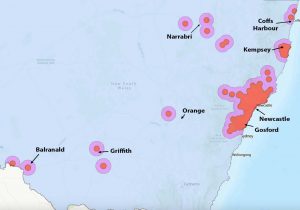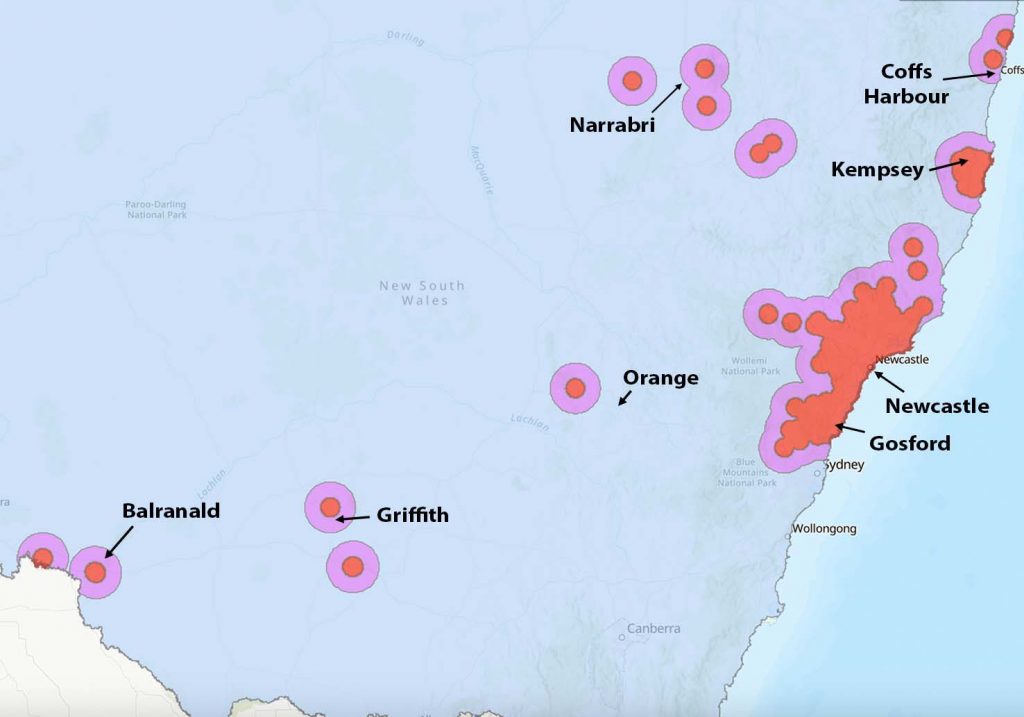THE VARROA MITE ERRADICATION ATTEMPT
In June 2022, Varroa Mites, serious pests of European honeybees, were discovered in NSW.
For 15 months, the NSW Department of Primary Industries (DPI) strived, without success, to eradicate the incursion. Thousands of managed hives of European honeybees were euthanised and a baiting program to destroy feral nests of European honeybees was rolled out in affected areas.
The DPI set up over 600 baiting stations that were periodically spiked with the pesticide, Fipronil. Baiting was done in all the Red Zones shown in the map, except for some Zones that were declared towards the conclusion of the Eradication Program. The pesticide, Fipronil, is highly toxic to bees and may remain active in honey for over two years1.

Map: The red areas on this map show the Varroa Mite Eradication Red Zones that were declared by the DPI. Toxic baiting with Fipronil was done within these zones, except for some that were declared right at the end of the Eradication Program.
The ANBA was concerned that native bees could be impacted if they collected poisoned honey from dead feral European honeybee nests in the Red Zones. So, in 2022, the ANBA advised native bee keepers to move their hives out of the Red Zones, and they launched a hive foster program to assist affected bee keepers.
The DPI Varroa Mite Eradication Program and the baiting program ended on 19 September 2023, when a decision was made that eradication was no longer feasible. Nevertheless, pesticide residues from the baiting were still in the environment and these could continue to impact local native bees and other pollinators in these areas for a long time2.
CURRENT ANBA ADVICE
Unfortunately, it is difficult to know how much Fipronil is still in the environment in a particular Red Zone, as this depends on many factors. For instance, in more severely-affected Red Zones:
- the Fipronil baiting work may have been done for a longer time; or
- the baiting program may have been more effective and may have poisoned higher numbers of feral European honeybee nests.
Furthermore, there have been reports from some Red Zones that South African Small Hive Beetles, another introduced pest of bees in NSW, have now infested many of the nests of feral honeybees that were poisoned by the Fipronil. Honey stores that are infested by Small Hive Beetles become putrid. These dead nests would no longer be attractive to native bees.
For these reasons, the ANBA advises native bee hive owners in the Red Zones to make local enquiries to assess for themselves the current risk of keeping stingless bees in their location. For instance:
- Have any apiarists brought their hives of commercial European honeybees back to your area and, if so, how healthy are those hives now?
- Are there any other hives or natural nests of native stingless bees in your area, and, if so, how healthy are those bees now?
WHAT WILL HAPPEN NEXT?
The Varroa Mites from this incursion are continuing to spread through NSW and, in due course, they will spread into other states. See the current distribution of Varroa Mites in NSW on this webpage: https://www.dpi.nsw.gov.au/emergencies/emergency/biosecurity/current-situation/varroa-mite-emergency-response
The future holds pluses and minuses for our native bees as these Varroa Mites spread:
1. Fortunately, these Varroa Mites cannot attack Australian native bees directly, because they are adapted to only breed in European honeybee nests.
2. Now that the DPI baiting program has ended, the risk that native bees may be impacted by toxic Fipronil residues from the baiting is reducing.
3. As Varroa Mites continue to spread through Australia, they will kill many feral European honeybee nests in the bush. This may help some populations of native bees because there may be less competition for nectar and pollen in those areas.
4. However, Varroa Mites can help spread a range of viruses that harm bees. It is possible that some of these viruses could spill over to native bees and affect them in years to come.
Further reading.
Varroa incursion – what does it mean for native bees?
References.
1. Taylor MA et. al. (2007) Destroying managed and feral honey bee (Apis mellifera) colonies to eradicate honey bee pests, New Zealand Journal of Crop and Horticultural Science, https://www.tandfonline.com/doi/abs/10.1080/01140670709510197
2. Koetz A and Hyatt S (2013) Asian honey bee (Apis cerana) remote nest treatment. Asian honey bee Transition to Management Program. Queensland Department of Agriculture, Fisheries and Forestry. Especially see summary point 3 on page 4, page 16, and the ‘Off-target species’ section on pages 17-18. https://www.planthealthaustralia.com.au/wp-content/uploads/2018/10/Asian-honey-bee-remote-nest-treatment-report.pdf

ANBA would like to thank Anne Dollin for her massive effort leading the ANBA Varroa Response project.
Visit Anne’s website here: https://www.aussiebee.com.au

